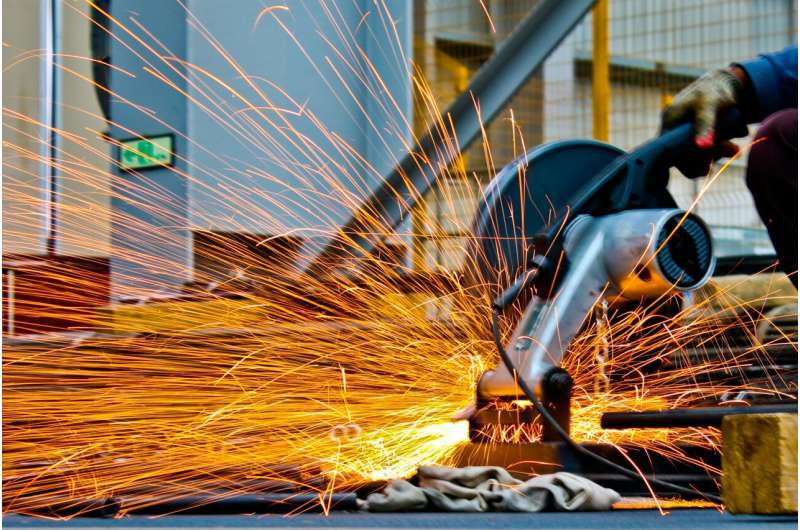
Steel production is the surprising source of 8% of all greenhouse gases today. Most of it comes when converting iron ore into molten iron. Usually, that means with coal. Clean-burning hydrogen fuel, on the other hand, which produces only pure water as its byproduct, represents a far more sustainable alternative and would likely have been adopted long ago if not for technical challenges that continue to favor coal.
Engineers are keen to change that calculus. Recently, Stanford’s Leora Dresselhaus-Marais and a multi-institutional team of colleagues revealed that it is the smallest nanoscale particles in iron ore that are the cause of those technical challenges. The finding, they say, could pave the way for new-age hydrogen-based “green steel” reactors.
“Hydrogen-based steel production becomes less efficient over time in a way that coal-fired plants do not, but no one understood exactly why,” says Dresselhaus-Marais, an assistant professor of materials science and engineering, regarding the study that was published in Proceedings of the National Academy of Sciences (PNAS). “Our purpose here was to establish the scientific principles governing the performance of reactors to improve existing reactors—or, potentially, to envision new, cleaner reactors of tomorrow.”
Shaving grace
The whiskering process is well known, but not well understood for myriad reasons. In the reactors, under the high heat of the hydrogen reaction, Dresselhaus-Marais explains, the nanoparticles that are always present in the ores self-assemble to form elongated, whisker-like structures that clog reactors and reduce efficiency over time. Eventually, this leads to reactor failure that has relegated hydrogen-based steel production to the back burner.
Dresselhaus-Marais and team resolved to solve the problem. They have illustrated the critical role nanoparticles play in whiskering. These tiny shavings, or “fines” as they are known, are prevalent in iron ore dust and are produced during ore processing and transport as larger millimeter-scale pellets of iron ore rub together. Fines particles can be about a hundred- to a hundred-thousand-times smaller than the average pellet.
Ironmaking is a multi-step process in which iron ore (hematite, Fe2O3) is oxidized first into magnetite (Fe3O4) and then to an intermediate material known as wüstite (Fe1-xO) before it can be refined into the pure iron (Fe) suitable for steelmaking.
The challenging step, the team reveals, is the transition from wüstite to pure iron. The researchers have explored and precisely described for the first time how exactly wüstite transitions to iron using advanced electron microscopy and X-ray scattering methods.
Streamlining the process
Previous studies of whiskering have looked only at the millimeter-scale pellets, overlooking the role fines play in the whiskering process. But it is precisely these smaller particles that matter most. At specific temperatures, they stick together creating the whiskers that clog reactors and cause failures.
“It turns out steel is one of the largest nanoparticle industries in existence,” Dresselhaus-Marais says. “We hope the industry can now harness the opportunities of nano chemistry to better control the hydrogen reduction process and avoid—or eliminate—whiskering.”
Those findings have important implications for the future of green steel. Specifically, Dresselhaus-Marais has shown that the reaction pathway is fundamentally different for nanoparticles than macroparticles, and that whiskering can occur among groups of nanoparticles alone, even when they don’t have macroparticles to latch onto.
“We suggest that it would be preferential to skip wüstite phase and go from magnetite straight to pure iron, but that is easier said than done,” she says. “Still, these new insights could open the steel industry to unconventional but promising feedstocks, possibly even bypassing pelletization altogether, to design and optimize new green steel processes for the future.”
More information:
Xueli Zheng et al, Correlating chemistry and mass transport in sustainable iron production, Proceedings of the National Academy of Sciences (2023). DOI: 10.1073/pnas.2305097120
Citation:
What’s standing in the way of sustainable steel? (2023, November 1)
retrieved 1 November 2023
from https://techxplore.com/news/2023-11-sustainable-steel.html
This document is subject to copyright. Apart from any fair dealing for the purpose of private study or research, no
part may be reproduced without the written permission. The content is provided for information purposes only.
Stay connected with us on social media platform for instant update click here to join our Twitter, & Facebook
We are now on Telegram. Click here to join our channel (@TechiUpdate) and stay updated with the latest Technology headlines.
For all the latest Technology News Click Here
For the latest news and updates, follow us on Google News.
